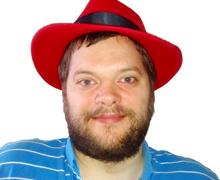Interview with Robert Kratky
Bridging the Gap between Legacy Docs and Modular Content

Robert Kratky will give a talk about Bridging the Gap between Legacy Docs and Modular Content at FOSDEM 2017.
Q: Could you briefly introduce yourself?
I work as a technical writer at Red Hat, which allows me to combine my passions for IT, open source, and languages. Outside of work, I like to travel, acquire new tastes, and have a glass of good wine.
Q: What will your talk be about, exactly? Why this topic?
My talk is about the way Red Hat tech writers are attempting to overcome limitations and deficiencies of IT documentation. We have identified the main problems that plague many upstream and downstream open-source docs, and we’ve also come up with specific methods to fix these problems. The crux of the matter is to avoid duplicate work and only document stuff that users really need documented. We go about this by modularizing the docs.
Q: What do you hope to accomplish by giving this talk? What do you expect?
I want to share what we’re working on and hope to both inspire other people or projects and get feedback. I’m also hoping for a discussion about problems users experience with documentation and any potential ideas how to fix them.
Q: When have the tech writers at Red Hat started re-purposing their existing body of documentation? And why did they start this endeavor?
We’ve started working on this about two years ago, but it was slow going at first because of resource constraints. As to why we started, I believe I answered that above, but a short answer is: “to improve user experience with open-source docs”.
Q: What’s wrong with traditional Linux documentation and why do we need a new kind of documentation? How have requirements and user expectations changed?
There’s nothing really ‘wrong’ with traditional Linux docs, but that doesn’t mean they can’t be improved. Open-source docs have always struggled with not having enough contributors. We recognize this and try to find a way to both cut down on the amount of docs and at the same time improve user experience with the docs – by carefully targeting specific user stories.
User expectations and requirements have been changing together with the way software is distributed and used. For example, many software projects no longer have a regular release cycle – instead, they’re released on a daily basis, and the traditional versioning scheme doesn’t apply. Docs that are tied to release cycles can’t really provide adequate support in such cases (not to mention that maintenance becomes a nightmare). There are other shifts as well, and we’re trying to come up with ways to accommodate these new circumstances.
Q: Does traditional documentation still have its place next to the newer types of documentation you’re working on?
Certainly. Ours is not a one-size-fits-all solution. There are still situations in which traditional docs come in handy. What we’re doing is developing a system that can – to a reasonable extent – satisfy both worlds. It’s also a question of resources, which is why we’re trying to kill two birds with one stone.
Q: Have you enjoyed previous FOSDEM editions?
Yes, very much. It’s quite amazing that despite the growth of the event, it has still managed to maintain its grass-roots atmosphere.

Creative Commons License
This interview is licensed under a Creative Commons Attribution 2.0 Belgium License.